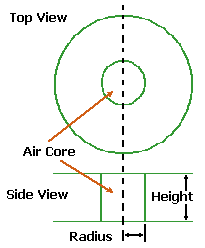
When you make the form, it should allow
you to create an inductor that has this general shape. It
may be possible to find pre-made forms, but you really
don't need one once the wire has been wrapped and secured.
|
You'll need to create a form (this could be made of plastic or wood; what ever
you have available) to wind your inductor in. You'll need to be able to
have the correctly sized opening to wind the core onto (the program gives
that as Radius - multiply this by 2 to get the diameter), and you'll need to
be able to brace the form to keep the windings together at the right width.
Once wound, use plastic/nylon Wire Ties, or electrical tape, to hold the
inductor together. These can become quite warm when in use. The DC Resistance
is an indicator of how much power these will soak up - the lower the DC
Resistance the better. For example, if you create a 10 mH inductor using 26
gauge wire, its DC Resistance is 7.89 Ohms - which is approximately the same
as the 8 ohm impedance of the Woofer - this implies that the Inductor will
absorb an equal amount of power as the Woofer will. If you try to pump 200
Watts into this, the Inductor will dissipate 50 percent (or 100 watts) and
will most likely fail in short time. Using 14 gauge wire changes the DC
Resistance to .86 Ohms, and instead, the Inductor absorbs only approximately
10 percent of the power (or 20 watts). It still gets warm, but it won't
fail catastrophically.
|

